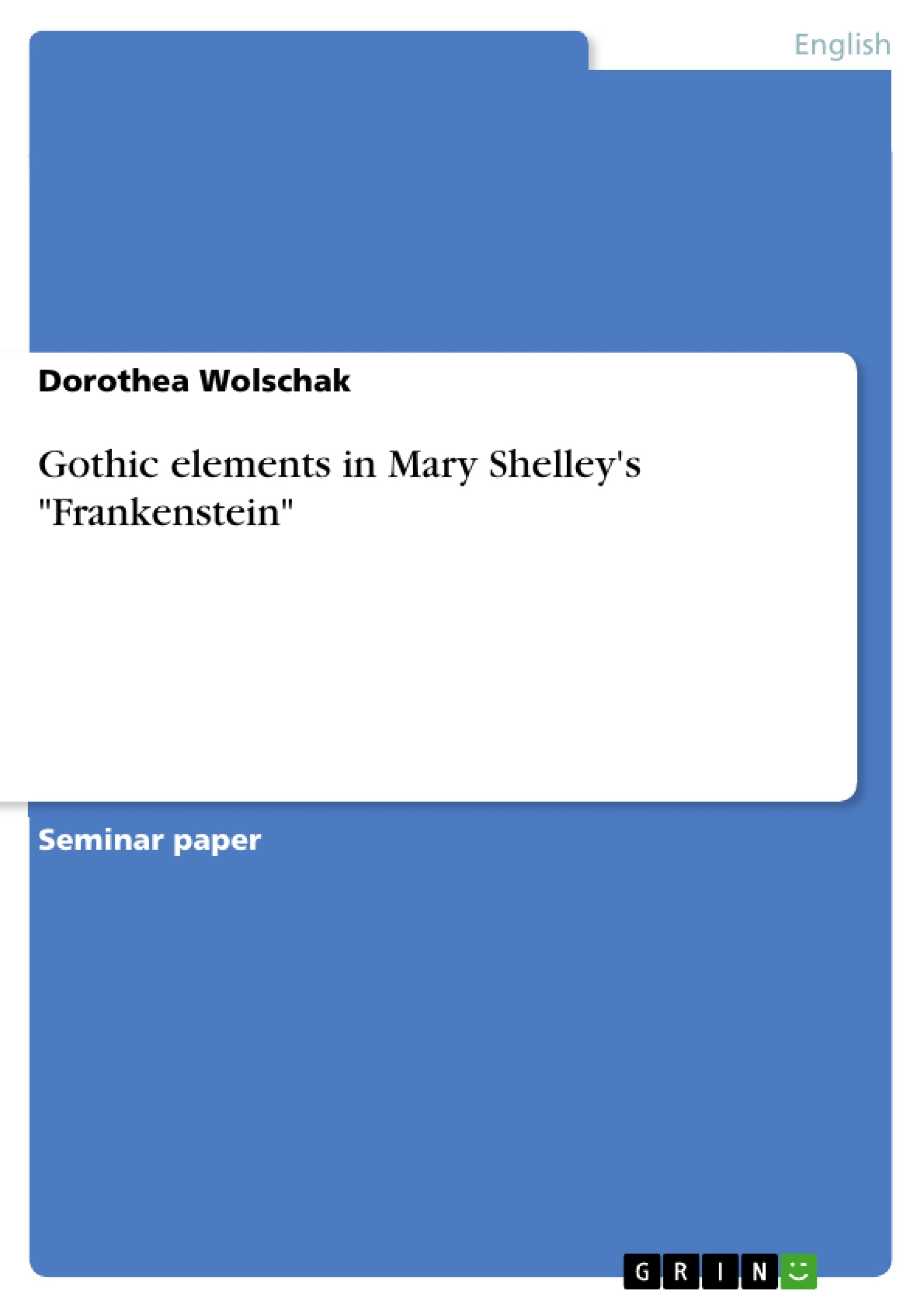With Frankenstein or The Modern Prometheus (1818) Mary Shelley succeeds to create a milestone in Horror fiction, which enjoys popularity to this day. Mary, the daughter of the famous writer William Godwin and the feminist author Mary Wollstonecraft and the wife of one of the major English Romantic poets Percy Bysshe Shelley, lived from 1797 to 1851. She accomplishes her masterpiece before the age of 20. Its prominent elements are supernatural incidents, scientific danger, persecution, distorted human beings, the sublime and terror. It is the fruit of a horror romance writing competition with her friends and a threatening nightmare.
Table of Contents
- 1. Introduction
- 2. Basics
- 3. Gothic elements in Mary Shelley's Frankenstein
- 3.1. Incest
- 3.2. Science
- 3.3. Doppelgänger
- 3.4. Body Horror: The Monster
- 3.5. The Sublime
- 3.6. Setting
- 3.7. The Victim and The Villain
- 4. Conclusion
- 5. Bibliography
Objectives and Key Themes
This paper aims to analyze the function of Gothic elements within Mary Shelley's Frankenstein. It explores how these elements contribute to the novel's overall effect and thematic resonance.
- The interplay between Enlightenment rationality and Romantic sensibility in the novel.
- The exploration of the dangers of unchecked scientific ambition.
- The use of Gothic tropes to depict themes of creation, monstrosity, and responsibility.
- The exploration of the monstrous both physically and psychologically.
- The role of setting and atmosphere in enhancing the Gothic horror.
Chapter Summaries
1. Introduction: This introductory chapter sets the stage by establishing the unsettling atmosphere of Frankenstein and its impact on the reader. It introduces the core concept of horror fiction, its appeal, and its ability to evoke a complex range of emotions, blending fear and fascination. The chapter contextualizes Mary Shelley's novel within the broader genre of horror fiction, highlighting its enduring popularity and its status as a seminal work. It also briefly touches on Shelley's life and the context surrounding the creation of Frankenstein, including the role of a horror writing competition and a frightening dream.
2. Basics: This chapter provides a historical overview of the Gothic novel, tracing its evolution from its beginnings in the late 18th century to the early 19th century. It explores the tension between Enlightenment ideals of reason and order and the Romantic emphasis on imagination and the supernatural. The chapter discusses the shift in the Gothic genre's portrayal of villains and victims, showing how the initial focus on clear-cut morality gave way to a more nuanced exploration of the human psyche and the complexities of good and evil. It also examines the societal and intellectual contexts that influenced the development of 19th-century Gothic fiction, such as the French and Industrial Revolutions and emerging scientific and philosophical theories.
3. Gothic elements in Mary Shelley's Frankenstein: This chapter delves into the specific Gothic elements present in Frankenstein, analyzing their individual functions and their contribution to the novel's overall effect. It promises a detailed examination of themes such as incest, science, doppelgängers, body horror, the sublime, setting, and the complex relationship between victim and villain.
Keywords
Gothic novel, Frankenstein, Mary Shelley, horror fiction, Romanticism, Enlightenment, science, creation, monstrosity, responsibility, sublime, body horror, doppelgänger, victim, villain, setting.
Mary Shelley's Frankenstein: A Comprehensive Language Preview - FAQ
What is this document?
This is a comprehensive language preview for an academic paper analyzing Gothic elements in Mary Shelley's Frankenstein. It includes a table of contents, objectives and key themes, chapter summaries, and keywords. The information is intended for academic use, facilitating analysis of the novel's themes in a structured manner.
What topics are covered in the Table of Contents?
The table of contents includes an introduction, a section on the basics of Gothic novels, a detailed chapter on Gothic elements in Frankenstein (covering incest, science, doppelgängers, body horror, the sublime, setting, and victim/villain dynamics), a conclusion, and a bibliography.
What are the objectives and key themes of the paper?
The paper aims to analyze the function of Gothic elements in Frankenstein, exploring their contribution to the novel's overall impact. Key themes include the interplay between Enlightenment rationality and Romantic sensibility, the dangers of unchecked scientific ambition, the depiction of creation, monstrosity, and responsibility through Gothic tropes, the exploration of monstrosity (physically and psychologically), and the role of setting and atmosphere in enhancing the Gothic horror.
What are the chapter summaries?
The introduction establishes Frankenstein's unsettling atmosphere and its impact, introducing horror fiction's appeal and contextualizing Shelley's novel within the genre. The "Basics" chapter provides a historical overview of the Gothic novel, tracing its evolution and exploring the tension between Enlightenment and Romantic ideals. The main chapter delves into the specific Gothic elements in Frankenstein, analyzing their functions and contributions to the novel's overall effect.
What are the keywords associated with this paper?
Keywords include Gothic novel, Frankenstein, Mary Shelley, horror fiction, Romanticism, Enlightenment, science, creation, monstrosity, responsibility, sublime, body horror, doppelgänger, victim, villain, and setting.
What is the intended audience for this preview?
This preview is intended for academic use, supporting structured analysis of thematic elements within Mary Shelley's Frankenstein.
Where can I find the full paper?
The full paper is not included in this preview. This document serves as a summary and overview of its contents.
- Arbeit zitieren
- Dorothea Wolschak (Autor:in), 2009, Gothic elements in Mary Shelley's "Frankenstein", München, GRIN Verlag, https://www.grin.com/document/275964



